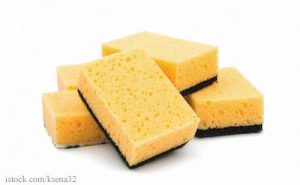NSF International, a not-for-profit organization that educates consumers about food and product safety, released a germ study in 2010 titled “Surprising Places Where Germs Like to Hide.” This year they plan on expanding that study by examining fifteen utensils and appliances in the kitchen that tend to trap and hold bacteria, molds, and yeast.

Food Poisoning Bulletin recently talked to Anna Schmitt Reichert, Director of Communications for the organization. She said, “our study found that the kitchen contained the most E. coli, Salmonella, yeast, and mold than the rest of the home. Most consumers think that the bathroom has the most pathogens, but that’s not true.”
The kitchen was the area where concentrations of coliform bacteria were highest. Coliform bacteria are used as indicators of sanitary conditions, since they are present in feces. The kitchen items that contained the highest concentrations of coliform bacteria were:
- Dish sponges and rags. In fact, these were the dirtiest items in the home, with more bacteria than the toilet seat or handle. To clean, microwave the wet sponge for two minutes every day. Replace your sponges/rags at least every two weeks. Towels, dishcloths, and rags can be washed in the hot water cycle with bleach to sanitize.
- The kitchen sink had the second highest concentration of microorganisms in the home. Reichert advises consumers to wash and disinfect the bottom and sides of the sink one or two times a week with a disinfecting cleanser. The kitchen drain and disposal can also hold bits of food that can be a growth medium for bacteria and mold; sanitize by pouring a solution of bleach and water down the drain.
- Coffee reservoir. This appliance was number five on the list of germiest places, after the toothbrush holder and pet bowls. The reservoir is damp and dark and warm, perfect conditions for mildew, molds, and bacteria. Reichert recommends that the reservoir be cleaned with vinegar at least monthly.
- Counter tops. Cross-contamination from raw meats, poultry, seafood, and eggs can easily occur on this surface. Disinfect the counter top every day.
- Cutting boards. This utensil also picks up bacteria and other pathogens while you’re cooking. Clean with hot water and soap after every use, and make sure it’s thoroughly cleaned after you use it to prepare raw meats, poultry, seafood, and eggs.
NSF’s new study will examine 15 kitchen appliances and utensils for bacterial and mold contamination. These items are:
- Stovetop lid handles
- Food storage container lids
- Blender blade assembly
- Spatulas
- Whisks
- Can openers
- Turkey basters
- Pizza cutters
- Strainers
- Microwave key pad
- Knife blocks
- Canister latches
- Vegetable compartment in fridge
- Insulating seal on fridge
- Kitchen shears
The study will look for coliform bacteria, E. coli, yeast, mold, and Staphylococcus. If you’re concerned about food safety, especially if you have a person in a high-risk group living in your household, pay attention to these items now. Wash them thoroughly, making sure soap and water or a disinfectant cleaning solution gets into the cracks and crevices. The study will be completed later this year.




